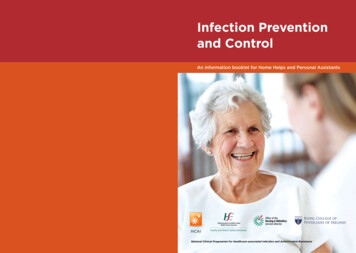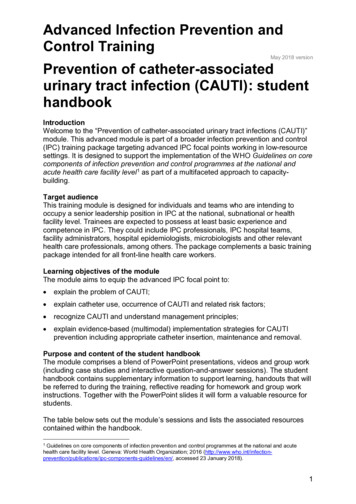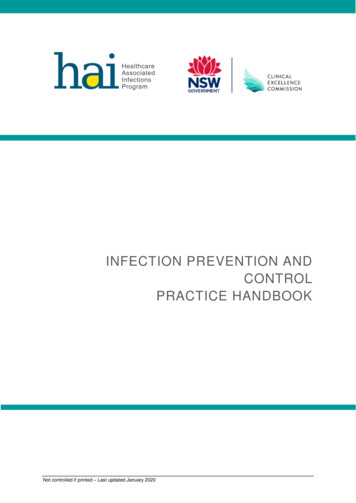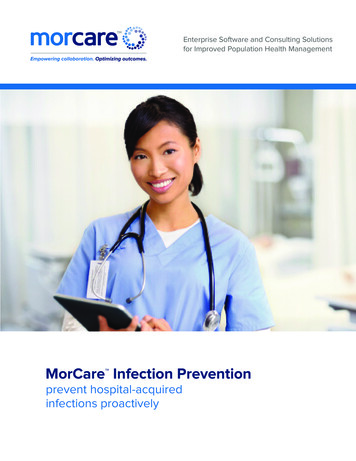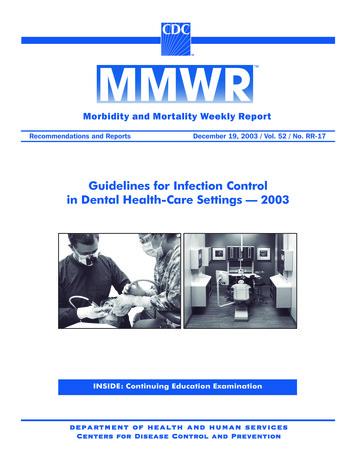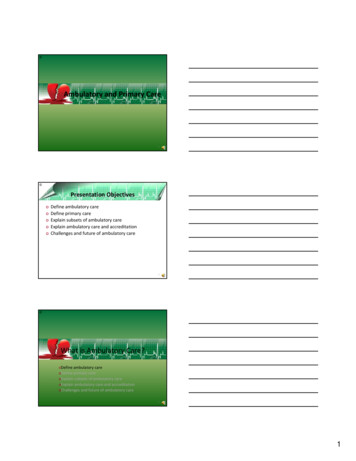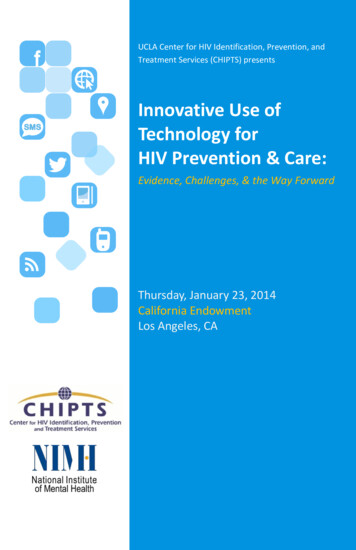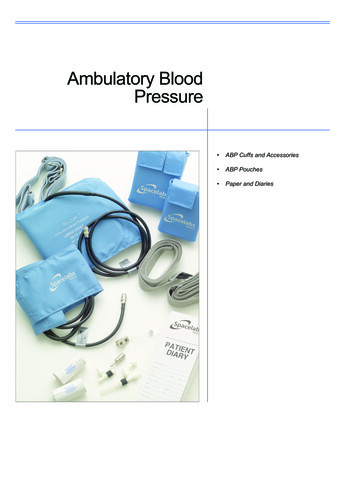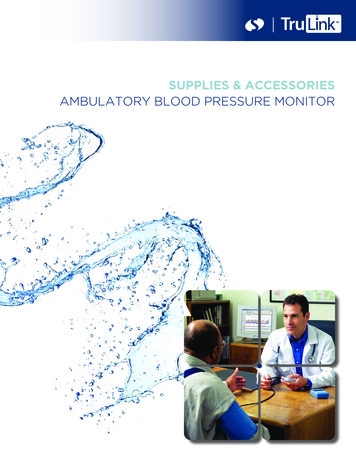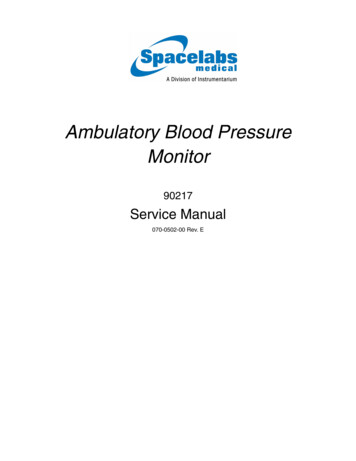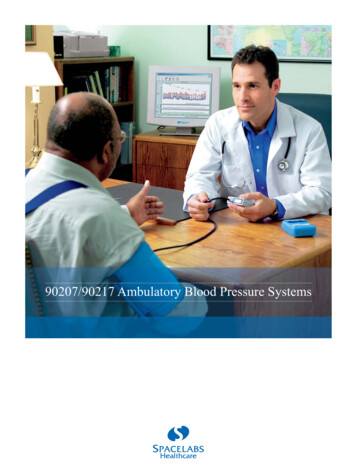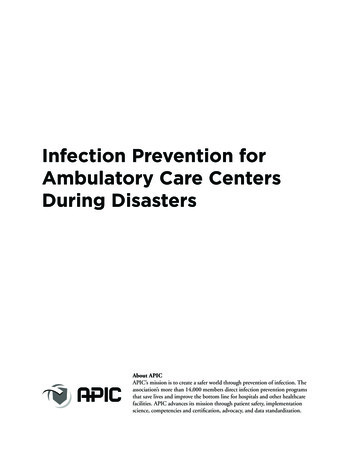
Transcription
Infection Prevention forAmbulatory Care CentersDuring DisastersAbout APICAPIC’s mission is to create a safer world through prevention of infection. Theassociation’s more than 14,000 members direct infection prevention programsthat save lives and improve the bottom line for hospitals and other healthcarefacilities. APIC advances its mission through patient safety, implementationscience, competencies and certification, advocacy, and data standardization.
Copyright 2013 by the Association for Professionals in Infection Control and Epidemiology, Inc. (APIC)All rights reserved. No part of this publication may be reproduced, stored in a retrieval system, or transmitted in anyform or by any means, electronic, mechanical, photocopied, recorded, or otherwise, without prior written permission ofthe publisher.Printed in the United States of AmericaFirst edition, February 2013ISBN: 1-933013-58-3All inquiries about this guide or other APIC products and services may be directed addressed to:APIC1275 K Street NW, Suite 1000Washington, DC 20005Phone: 202-789-1890Fax: 202-789-1899Email: info@apic.orgWeb: www.apic.orgDisclaimerAPIC provides information and services as a benefit to both APIC members and the general public. The material presentedin this guide has been prepared in accordance with generally recognized infection prevention principles and practices andis for general information only. It is not intended to provide, or act as a substitute for, medical advice, and the user shouldconsult a health care professional for matters regarding health and/or symptoms that may require medical attention. Theguide and the information and materials contained therein are provided “AS IS”, and APIC makes no representationor warranty of any kind, whether express or implied, including but not limited to, warranties of merchantability,noninfringement, or fitness, or concerning the accuracy, completeness, suitability, or utility of any information, apparatus,product, or process discussed in this resource, and assumes no liability therefore.
Infection Prevention for Ambulatory Care Centers During DisastersTable of ContentsAcknowledgments . . . . . . . . . . . . . . . . . . . . . . . . . . . . . . . . . . . . . . . . . . . . . . . . . . . . . . . . . . . . . . . . . . 6Declarations of Conflicts of Interest . . . . . . . . . . . . . . . . . . . . . . . . . . . . . . . . . . . . . . . . . . . . . . . . . . . . 8Introduction. . . . . . . . . . . . . . . . . . . . . . . . . . . . . . . . . . . . . . . . . . . . . . . . . . . . . . . . . . . . . . . . . . . . . . . 9Overview. . . . . . . . . . . . . . . . . . . . . . . . . . . . . . . . . . . . . . . . . . . . . . . . . . . . . . . . . . . . . . . . . . . . . . . . 11Infection Prevention Program and Plan . . . . . . . . . . . . . . . . . . . . . . . . . . . . . . . . . . . . . . . . . . . . . . . . . 12Infection Prevention Coverage/Oversight. . . . . . . . . . . . . . . . . . . . . . . . . . . . . . . . . . . . . . . . . . . . . . . . 13Patient Scheduling. . . . . . . . . . . . . . . . . . . . . . . . . . . . . . . . . . . . . . . . . . . . . . . . . . . . . . . . . . . . . . . . . 14Triage and Surveillance. . . . . . . . . . . . . . . . . . . . . . . . . . . . . . . . . . . . . . . . . . . . . . . . . . . . . . . . . . . . . . 15Syndromic Surveillance. . . . . . . . . . . . . . . . . . . . . . . . . . . . . . . . . . . . . . . . . . . . . . . . . . . . . . . . . 15Screening/Identifying Potentially Contagious Individuals . . . . . . . . . . . . . . . . . . . . . . . . . . . . . . . 15Frequency of Screening . . . . . . . . . . . . . . . . . . . . . . . . . . . . . . . . . . . . . . . . . . . . . . . . . . . . . . . . . . . . . 17Patient and Visitor Screening. . . . . . . . . . . . . . . . . . . . . . . . . . . . . . . . . . . . . . . . . . . . . . . . . . . . . 17Ambulatory Care Center Staff Screening. . . . . . . . . . . . . . . . . . . . . . . . . . . . . . . . . . . . . . . . . . . . 17Infection Prevention Triage. . . . . . . . . . . . . . . . . . . . . . . . . . . . . . . . . . . . . . . . . . . . . . . . . . . . . . . . . . . 18Triage Area. . . . . . . . . . . . . . . . . . . . . . . . . . . . . . . . . . . . . . . . . . . . . . . . . . . . . . . . . . . . . . . . . . . . . . . 19Post Discharge Surveillance . . . . . . . . . . . . . . . . . . . . . . . . . . . . . . . . . . . . . . . . . . . . . . . . . . . . . . . . . . 20Surveillance Data Analysis. . . . . . . . . . . . . . . . . . . . . . . . . . . . . . . . . . . . . . . . . . . . . . . . . . . . . . . . . . . 21Occupational Health Issues . . . . . . . . . . . . . . . . . . . . . . . . . . . . . . . . . . . . . . . . . . . . . . . . . . . . . . . . . . 22Staff Immunization, Anti-infective Therapy, and Prophylaxis. . . . . . . . . . . . . . . . . . . . . . . . . . . . . 22Furloughing Staff. . . . . . . . . . . . . . . . . . . . . . . . . . . . . . . . . . . . . . . . . . . . . . . . . . . . . . . . . . . . . . 23Vulnerable Staff. . . . . . . . . . . . . . . . . . . . . . . . . . . . . . . . . . . . . . . . . . . . . . . . . . . . . . . . . . . . . . . 23Cohorting Staff. . . . . . . . . . . . . . . . . . . . . . . . . . . . . . . . . . . . . . . . . . . . . . . . . . . . . . . . . . . . . . . 23Blood/Body Fluid Exposures. . . . . . . . . . . . . . . . . . . . . . . . . . . . . . . . . . . . . . . . . . . . . . . . . . . . . 23Anti-infective Therapy, Immunization, and Prophylaxis of Ambulatory Care Center Patientsand Visitors. . . . . . . . . . . . . . . . . . . . . . . . . . . . . . . . . . . . . . . . . . . . . . . . . . . . . . . . . . . . . . . . . . 24Visitor Management. . . . . . . . . . . . . . . . . . . . . . . . . . . . . . . . . . . . . . . . . . . . . . . . . . . . . . . . . . . . . . . . 26Reporting Procedures. . . . . . . . . . . . . . . . . . . . . . . . . . . . . . . . . . . . . . . . . . . . . . . . . . . . . . . . . . . . . . . 27Standard Precautions . . . . . . . . . . . . . . . . . . . . . . . . . . . . . . . . . . . . . . . . . . . . . . . . . . . . . . . . . . . . . . . 28Transmission-based Precautions/Isolation. . . . . . . . . . . . . . . . . . . . . . . . . . . . . . . . . . . . . . . . . . . . . . . . 29Airborne Precautions. . . . . . . . . . . . . . . . . . . . . . . . . . . . . . . . . . . . . . . . . . . . . . . . . . . . . . . . . . . 29Contact Precautions. . . . . . . . . . . . . . . . . . . . . . . . . . . . . . . . . . . . . . . . . . . . . . . . . . . . . . . . . . . . 31Droplet Precautions. . . . . . . . . . . . . . . . . . . . . . . . . . . . . . . . . . . . . . . . . . . . . . . . . . . . . . . . . . . . 32Isolation Area. . . . . . . . . . . . . . . . . . . . . . . . . . . . . . . . . . . . . . . . . . . . . . . . . . . . . . . . . . . . . . . . . 32Placement of Individuals. . . . . . . . . . . . . . . . . . . . . . . . . . . . . . . . . . . . . . . . . . . . . . . . . . . . . . . . 33Patient Transfer . . . . . . . . . . . . . . . . . . . . . . . . . . . . . . . . . . . . . . . . . . . . . . . . . . . . . . . . . . . . . . . 33Quarantine. . . . . . . . . . . . . . . . . . . . . . . . . . . . . . . . . . . . . . . . . . . . . . . . . . . . . . . . . . . . . . . . . . . . . . . 34Association for Professionals in Infection Control and Epidemiology 3
Infection Prevention for Ambulatory Care Centers During DisastersHand Hygiene. . . . . . . . . . . . . . . . . . . . . . . . . . . . . . . . . . . . . . . . . . . . . . . . . . . . . . . . . . . . . . . . . . . .Hand Hygiene Technique . . . . . . . . . . . . . . . . . . . . . . . . . . . . . . . . . . . . . . . . . . . . . . . . . . . . . . .Hand Hygiene Signage . . . . . . . . . . . . . . . . . . . . . . . . . . . . . . . . . . . . . . . . . . . . . . . . . . . . . . . . .Personal Protective Equipment. . . . . . . . . . . . . . . . . . . . . . . . . . . . . . . . . . . . . . . . . . . . . . . . . . . . . . . .Gloves. . . . . . . . . . . . . . . . . . . . . . . . . . . . . . . . . . . . . . . . . . . . . . . . . . . . . . . . . . . . . . . . . . . . . .Gowns. . . . . . . . . . . . . . . . . . . . . . . . . . . . . . . . . . . . . . . . . . . . . . . . . . . . . . . . . . . . . . . . . . . . . .Eye Protection. . . . . . . . . . . . . . . . . . . . . . . . . . . . . . . . . . . . . . . . . . . . . . . . . . . . . . . . . . . . . . . .Goggles. . . . . . . . . . . . . . . . . . . . . . . . . . . . . . . . . . . . . . . . . . . . . . . . . . . . . . . . . . . . . . . . . . . . .Face Shields. . . . . . . . . . . . . . . . . . . . . . . . . . . . . . . . . . . . . . . . . . . . . . . . . . . . . . . . . . . . . . . . . .Full-face Respirators. . . . . . . . . . . . . . . . . . . . . . . . . . . . . . . . . . . . . . . . . . . . . . . . . . . . . . . . . . . .Removal and Reprocessing of Eye Protection. . . . . . . . . . . . . . . . . . . . . . . . . . . . . . . . . . . . . . . . .Respirators and Masks. . . . . . . . . . . . . . . . . . . . . . . . . . . . . . . . . . . . . . . . . . . . . . . . . . . . . . . . . .Shortage of Respirators and Masks. . . . . . . . . . . . . . . . . . . . . . . . . . . . . . . . . . . . . . . . . . . . . . . . .Specimen Collection, Handling, and Transport . . . . . . . . . . . . . . . . . . . . . . . . . . . . . . . . . . . . . . . . . . .Procedures. . . . . . . . . . . . . . . . . . . . . . . . . . . . . . . . . . . . . . . . . . . . . . . . . . . . . . . . . . . . . . . . . . .Water Management. . . . . . . . . . . . . . . . . . . . . . . . . . . . . . . . . . . . . . . . . . . . . . . . . . . . . . . . . . . . . . . .Water Usage. . . . . . . . . . . . . . . . . . . . . . . . . . . . . . . . . . . . . . . . . . . . . . . . . . . . . . . . . . . . . . . . . .Water Collection and Storage. . . . . . . . . . . . . . . . . . . . . . . . . . . . . . . . . . . . . . . . . . . . . . . . . . . . .Water Decontamination. . . . . . . . . . . . . . . . . . . . . . . . . . . . . . . . . . . . . . . . . . . . . . . . . . . . . . . . .Water from Local Reservoirs, Lakes, and Rivers. . . . . . . . . . . . . . . . . . . . . . . . . . . . . . . . . . . . . . .Well Water. . . . . . . . . . . . . . . . . . . . . . . . . . . . . . . . . . . . . . . . . . . . . . . . . . . . . . . . . . . . . . . . . . .Food Safety . . . . . . . . . . . . . . . . . . . . . . . . . . . . . . . . . . . . . . . . . . . . . . . . . . . . . . . . . . . . . . . . . . . . . .Safe Handling of Human Food . . . . . . . . . . . . . . . . . . . . . . . . . . . . . . . . . . . . . . . . . . . . . . . . . . .Waste Management . . . . . . . . . . . . . . . . . . . . . . . . . . . . . . . . . . . . . . . . . . . . . . . . . . . . . . . . . . . . . . . .Regular Trash. . . . . . . . . . . . . . . . . . . . . . . . . . . . . . . . . . . . . . . . . . . . . . . . . . . . . . . . . . . . . . . . .Regulated Medical Waste. . . . . . . . . . . . . . . . . . . . . . . . . . . . . . . . . . . . . . . . . . . . . . . . . . . . . . . .Human Waste . . . . . . . . . . . . . . . . . . . . . . . . . . . . . . . . . . . . . . . . . . . . . . . . . . . . . . . . . . . . . . . .Patient Decontamination. . . . . . . . . . . . . . . . . . . . . . . . . . . . . . . . . . . . . . . . . . . . . . . . . . . . . . . . . . . .Physical Plant/Facility Needs Related to Infection Prevention . . . . . . . . . . . . . . . . . . . . . . . . . . . . . . . .Environmental Decontamination. . . . . . . . . . . . . . . . . . . . . . . . . . . . . . . . . . . . . . . . . . . . . . . . . . . . . .Selection of Cleaning/Disinfecting Agents. . . . . . . . . . . . . . . . . . . . . . . . . . . . . . . . . . . . . . . . . . .Cleaning and Disinfection Supplies. . . . . . . . . . . . . . . . . . . . . . . . . . . . . . . . . . . . . . . . . . . . . . . .Cleaning Body Fluid Spills. . . . . . . . . . . . . . . . . . . . . . . . . . . . . . . . . . . . . . . . . . . . . . . . . . . . . . .Cleaning Environmental Surfaces. . . . . . . . . . . . . . . . . . . . . . . . . . . . . . . . . . . . . . . . . . . . . . . . .Cleaning Beds/Stretchers/Cots/Mattresses. . . . . . . . . . . . . . . . . . . . . . . . . . . . . . . . . . . . . . . . . . .Linens/Laundry Management . . . . . . . . . . . . . . . . . . . . . . . . . . . . . . . . . . . . . . . . . . . . . . . . . . . .Washing Healthcare Linens. . . . . . . . . . . . . . . . . . . . . . . . . . . . . . . . . . . . . . . . . . . . . . . . . . . . . .Cleaning, Disinfecting, and Sterilizing Medical Equipment. . . . . . . . . . . . . . . . . . . . . . . . . . . . . .Dialysis . . . . . . . . . . . . . . . . . . . . . . . . . . . . . . . . . . . . . . . . . . . . . . . . . . . . . . . . . . . . . . . . . . . . . . . . .Surgery. . . . . . . . . . . . . . . . . . . . . . . . . . . . . . . . . . . . . . . . . . . . . . . . . . . . . . . . . . . . . . . . . . . . . . . . . .Miscellaneous Medical Procedures. . . . . . . . . . . . . . . . . . . . . . . . . . . . . . . . . . . . . . . . . . . . . . . . . . . . .Toys . . . . . . . . . . . . . . . . . . . . . . . . . . . . . . . . . . . . . . . . . . . . . . . . . . . . . . . . . . . . . . . . . . . . . . . . . . .Toy Selection. . . . . . . . . . . . . . . . . . . . . . . . . . . . . . . . . . . . . . . . . . . . . . . . . . . . . . . . . . . . . . . . .Handling and Cleaning Communal Toys. . . . . . . . . . . . . . . . . . . . . . . . . . . . . . . . . . . . . . . . . . . .4Association for Professionals in Infection Control and 49495151525252535455565657585858595960616263646464
Infection Prevention for Ambulatory Care Centers During DisastersFrequency of Toy Cleaning and Disinfecting. . . . . . . . . . . . . . . . . . . . . . . . . . . . . . . . . . . . . . . . . 65Procedure for Cleaning Toys of Noninfected/Well-appearing Children . . . . . . . . . . . . . . . . . . . . . 65Procedure for Cleaning Toys of Infected/Isolated or Ill Children . . . . . . . . . . . . . . . . . . . . . . . . . . 66Handling and Cleaning of Noncommunal Toys. . . . . . . . . . . . . . . . . . . . . . . . . . . . . . . . . . . . . . . 66Pest Management. . . . . . . . . . . . . . . . . . . . . . . . . . . . . . . . . . . . . . . . . . . . . . . . . . . . . . . . . . . . . . . . . . 67Animal Management. . . . . . . . . . . . . . . . . . . . . . . . . . . . . . . . . . . . . . . . . . . . . . . . . . . . . . . . . . . . . . . 69Postmortem Care. . . . . . . . . . . . . . . . . . . . . . . . . . . . . . . . . . . . . . . . . . . . . . . . . . . . . . . . . . . . . . . . . . 70Infection Prevention Education/Training. . . . . . . . . . . . . . . . . . . . . . . . . . . . . . . . . . . . . . . . . . . . . . . . 71References . . . . . . . . . . . . . . . . . . . . . . . . . . . . . . . . . . . . . . . . . . . . . . . . . . . . . . . . . . . . . . . . . . . . . . . 72AppendicesAppendix A: Statement of Authority for Infection Prevention at the Ambulatory Care Center. . . . 78Appendix B: List of Infection Prevention Equipment/Supplies Needed for AmbulatoryCare Centers. . . . . . . . . . . . . . . . . . . . . . . . . . . . . . . . . . . . . . . . . . . . . . . . . . . . . . . . . . . . . 79Appendix C: Syndromic Surveillance Assessment/Triage Form. . . . . . . . . . . . . . . . . . . . . . . . . . . . 81Appendix D: Syndromic Surveillance Poster . . . . . . . . . . . . . . . . . . . . . . . . . . . . . . . . . . . . . . . . . 82Appendix E: Infection Control Triage . . . . . . . . . . . . . . . . . . . . . . . . . . . . . . . . . . . . . . . . . . . . . . 83Appendix F: Example of Ambulatory Care Center Triage/Waiting Area Layout. . . . . . . . . . . . . . . 84Appendix G: Suggested Work Restrictions for Healthcare Workers with a Knownor Suspected Contagious Disease/Condition. . . . . . . . . . . . . . . . . . . . . . . . . . . . . . . . . . . . . 85Appendix H: Respiratory Etiquette Poster. . . . . . . . . . . . . . . . . . . . . . . . . . . . . . . . . . . . . . . . . . . 88Appendix I: Hand Hygiene Poster. . . . . . . . . . . . . . . . . . . . . . . . . . . . . . . . . . . . . . . . . . . . . . . . . 89Appendix J: Isolation Signs/Posters . . . . . . . . . . . . . . . . . . . . . . . . . . . . . . . . . . . . . . . . . . . . . . . . 90Appendix K: Hand Hygiene Techniques . . . . . . . . . . . . . . . . . . . . . . . . . . . . . . . . . . . . . . . . . . . . 93Appendix L: PPE Usage Posters from CDC. . . . . . . . . . . . . . . . . . . . . . . . . . . . . . . . . . . . . . . . . . 95Appendix M: Respirator Usage Poster from CDC. . . . . . . . . . . . . . . . . . . . . . . . . . . . . . . . . . . . . 97Appendix N: Water Decontamination Methods. . . . . . . . . . . . . . . . . . . . . . . . . . . . . . . . . . . . . . . 99Appendix O: Well Water Disinfection. . . . . . . . . . . . . . . . . . . . . . . . . . . . . . . . . . . . . . . . . . . . . 100Appendix P: Refrigerator Temperature Monitoring Log. . . . . . . . . . . . . . . . . . . . . . . . . . . . . . . . 102Appendix Q: Disposal of Waste Generated in an Ambulatory Care Center during Disasters . . . . 103Appendix R: Environmental Response Strategies for Floods and/or Sewage Spillsor Malfunctions Checklist. . . . . . . . . . . . . . . . . . . . . . . . . . . . . . . . . . . . . . . . . . . . . . . . . . 104Appendix S: List of Infection Prevention Physical Plant Issues. . . . . . . . . . . . . . . . . . . . . . . . . . . 106Appendix T: Disinfection and Sterilization Table. . . . . . . . . . . . . . . . . . . . . . . . . . . . . . . . . . . . . 107Appendix U: Central Line–associated Bloodstream Infection Prevention. . . . . . . . . . . . . . . . . . . 108Appendix V: Catheter-related Urinary Tract Infection Prevention . . . . . . . . . . . . . . . . . . . . . . . . 109Appendix W: Toys in an ACC. . . . . . . . . . . . . . . . . . . . . . . . . . . . . . . . . . . . . . . . . . . . . . . . . . . 110Appendix X: List of ACC Workers Requiring Infection Prevention Education. . . . . . . . . . . . . . . 111Appendix Y: List of Infection Prevention Education/Training Topics. . . . . . . . . . . . . . . . . . . . . . 112Association for Professionals in Infection Control and Epidemiology 5
Infection Prevention for Ambulatory Care Centers During DisastersAcknowledgmentsAccomplishing this comprehensive update required input and expertise from a broad array of expertsfrom practice and research settings. The Association for Professionals in Infection Control andEpidemiology acknowledges the valuable contributions of the following individuals:Lead authorTerri Rebmann, PhD, RN, CICAssociate ProfessorSaint Louis University, School of Public Health - Institute for BiosecuritySt. Louis, MissouriContributorsSteve Hilley, RNInfection Prevention CoordinatorYampa Valley Medical CenterSteamboat Springs, ColoradoMark McCaulley, MD, FACPYampa Valley Medical CenterSteamboat Springs, ColoradoNeil Pascoe, RN, BSN, CICEpidemiologistTexas Department of State Health ServicesAustin, TexasBarbara Russell, RN, MPH, CICDirector of Infection ControlBaptist Hospital of MiamiMiami, FloridaJacie Volkman, MPH, CICManager of Infection PreventionMission Health SystemAsheville, North Carolina6 Association for Professionals in Infection Control and Epidemiology
Infection Prevention for Ambulatory Care Centers During DisastersWilliam Wagner, ScD, CHCM, CHSP, CHEPVice President, Quality ComplianceTSIG ConsultingMarietta, GeorgiaReviewersSheryl Gordon, MSN, RN, CICAmerican Academy of Ambulatory Care Nursing (AAACN)University of New Mexico HospitalAlbuquerque, New MexicoGina Throneberry, RN, MBA, CASC, CNORDirector of Education and Clinical AffairsAmbulatory Surgery Center Association (ASCA)Alexandria, VirginiaMarsha Wallander, RNAssistant Director, Accreditation ServicesAccreditation Association for Ambulatory Health Care (AAAHC)Skokie, IllinoisAssociation for Professionals in Infection Control and Epidemiology 7
Infection Prevention for Ambulatory Care Centers During DisastersDeclarations of Conflicts of InterestTerri Rebmann, PhD, RN, C
Individuals whose medical needs exceed that which can be provided at the ACC, those that require an overnight stay, or those requiring specialty care should be transferred to a hospital, alternate care site, or other appropriate medical facility as soon as feasible. ACCs fill a necessary role in
